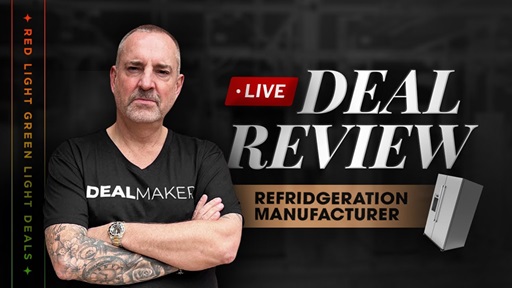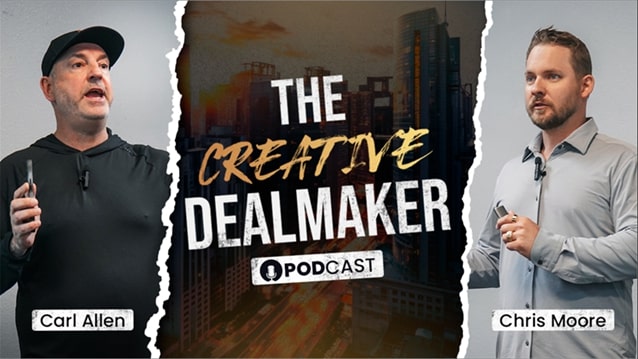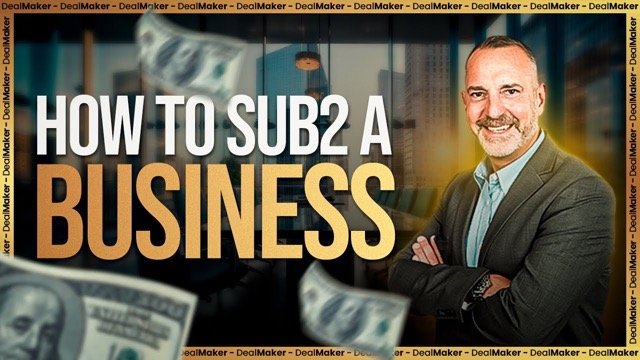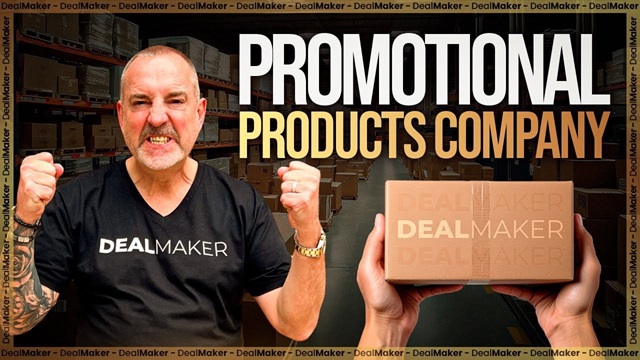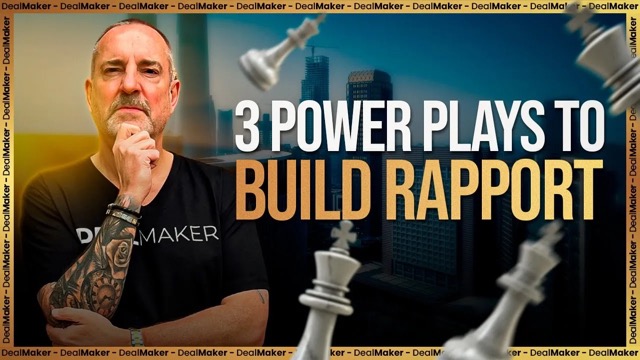Long-Term Investment Success: The Power of Business Roll Ups!
Long-Term Investment Success: The Power of Business Roll Ups!
In this engaging podcast episode, we delve into a transformative business acquisition strategy: the power of business roll-ups. Hosted by Carl Allen, this conversation spotlights how entrepreneurs can strategically consolidate multiple businesses to achieve significant growth, scale, and eventual high-value exits.
The featured presenter, a seasoned professional in the business acquisition space, shares their journey of building a roll-up strategy centered on a roofing company in Scottsdale, Arizona. With eight years of operational history and a strong foundation, this company serves as the cornerstone for a broader growth initiative. The deal under LOI (Letter of Intent) exemplifies a strategic partnership where the current owner retains equity and lends industry expertise, ensuring a seamless transition and scalability.
This episode unpacks critical aspects of the roll-up process, including deal structuring, capital raising, and the financial metrics driving investment decisions. With a $900,000 valuation and a three-year EBITDA average of $260,000, the company demonstrates robust growth potential. Key strategies discussed include geographic expansion, lead generation enhancements, and bolt-on acquisitions, creating a blueprint for success in a competitive market.
Listeners will gain insights into seller psychology, from fostering trust and alignment to leveraging the seller’s ongoing involvement in scaling operations. The podcast also highlights the importance of due diligence, especially regarding financial transparency and asset management. Moreover, it explores the dynamics of raising capital through a mix of equity and debt injections, offering a pragmatic roadmap for aspiring dealmakers.
A special focus is placed on the roofing industry’s unique challenges and opportunities, from its dependence on residential projects to the potential for diversification into commercial markets. With expert commentary and actionable advice, this episode equips listeners with a clear understanding of the roll-up strategy’s power, whether they are seasoned investors or newcomers to business acquisitions.
Carl Allen and the guest presenter leave no stone unturned, making this podcast a must-listen for anyone aiming to leverage roll-ups to create exponential business growth. The discussion combines vision with practical application, showcasing how roll-ups can transform fragmented industries into cohesive, high-performing entities.
Full Transcript:
Alright. So, excited to be here and presenting. I’ve been in the community for about a year and a half, and this is my first time presenting on red light green light. So, excited to share this with you.
I haven’t always been keen on partnerships, but since joining this mentorship, this community, I’ve seen a lot of success with, partnerships, and, it’s really inspired me to, you know, pursue what we’re pursuing here. And, the the company we’re looking at is a roofing company here in, in Scottsdale.
It’s been around for eight years, and this we’re we’re actually under LOI.
So we’ve, we’re acquiring seventy five percent of this business. The owner is staying on and retaining equity.
He has a pretty small team.
I think their USP is really the ability to move fast and price competitively.
But I there’s a lot of, value add opportunities with this particular deal.
So we are raising capital for this deal. We’re seeking five hundred and fifty k. We’d like to get a combination of, equity and debt injection.
Just some some information on the roofing industry in general. I know some of the other markets outside of Arizona are very, heavy on the insurance work. In Arizona, we don’t get a lot of storms or a lot of adverse weather, so a lot of the work they do is, repair and replacement.
And, ninety nine percent of the this particular company’s business is, residential, with a very small, minimal commercial work that they do.
We’re breaking down, the roofing market opportunity to, the serviceable attainable market here in Phoenix. It’s a growing market.
There’s about close to five million people here in the Greater Phoenix area. This particular company is only serving the East Valley, which makes up of Scottsdale, Tempe, and Mesa.
So I think there’s a huge opportunity to expand the geographical footprint.
We’ve been developing a lead generation machine that’s actually starting to bring in some lead flow. We’ve passed on a few smaller roofing companies, just because they they just didn’t fit. But if we go through and close on this particular deal, I think they’d make for great bolt ons to this particular roofing company.
So the financials, it’s averaging around two million a year in top line revenue with margins between twelve and and and fourteen percent. There was a slight dip in twenty twenty two.
In twenty two, this particular owner acquired this business from the previous owner. So, during the transition, you know, there was a a slight dip. But as you can see year over year, the margins have continued to grow.
This particular year, looking at p and l’s and financials for this year, they are on track for a ten percent increase year over year, with, the the adjusted EBITDA for, average three years is about two sixty. Although last year, they did about three hundred and fifteen in adjusted EBITDA. So if we continue with the, you know, ten percent year over year mark and by twenty six, we should be up to six hundred k in adjusted EBITDA.
So the acquisition structure, we’ve evaluated the business at nine hundred k. Like I mentioned, we’re acquiring seventy five percent of the business with the owner staying on.
I’ve we’ve built some amazing rapport with this owner. You know, we’ve explained, and he’s he’s very much on board with the roll up strategy that we have in place, in acquiring other roofing companies throughout the country. So he’s he’s gonna bring the industry expertise and the experience.
He also owns a coaching business where he helps contractors of all trades grow and scale their business.
I actually met him in September of last year, and I invited him to the Dealmaker event. So he was actually in attendance in the Dealmaker event in Scottsdale.
I introduced him to Carl and, you know, we told him a little bit about what he was doing with this coaching community. And, you know, Carl said it was a a great strategy for the Trojan horse method in coaching some of these contractors, some of these tradespeople, and then potentially purchasing their businesses, from them, you know, when when they’re ready to exit.
So the value add opportunities we see, you know, right now, it’s a pretty small team.
The project management’s always also doing sales and admin. So I think by adding a a sales team, you know, that can really drive and grow the the business as well as a increased focus on commercial sales.
I think they’re leaving a lot of money on the table there, and, you know, developing a sales team developing the commercial sales side should drive and and grow this business. And like I mentioned earlier, the bolt on strategies with some of these smaller deals that we’ve passed on, I think, this would be a good platform business to to bolt on to. And, the same thing for the geographical expansion. We’ve passed on a couple of deals in Tucson, just because it’s a couple of hours from here. But, with this particular business and and and bolting on some of those smaller ones and expanding the geographical footprint is is really gonna help drive and grow the business.
As mentioned, we are working on a roll up. We do have some pretty good deal flow. This particular deal is under LOI. So like I said, we are raising capital.
We do have two other LOIs out there, hoping to get, hoping to get a response on those here pretty soon, but, you know, we have some leads and some deals that are flowing. So everything is off market. We haven’t really messed with any broker deals at all. We’re going straight direct to seller.
And, you know, it it’s pretty awesome. And and the the lead generation system that, my partner, Caleb Caleb’s actually in Protege, but he couldn’t be here today. He had another another, meeting to attend to. So, he’s actually the one that’s leading the the lead generation and and the systems for us.
As mentioned, it’s a pretty small team.
The GM there’s a GM. The the owner really he spends pretty minimal time in the business, and and really what he’s doing is quality control.
That’s why I think the development of a sales team is gonna be crucial for a business like this in in driving and growing this business.
So three acquisition experts, all three of us have acquired businesses. We have, twenty five years in in combined experience. The thirty five million in combined sales is is Tyler, the the current owner. He’s already had a successful exit selling a pool company back in Tennessee. And as mentioned, he has a community of contractors that he coaches on a, you know, on a community level and also on a one on one basis and and combined, the clients that he’s coaches, that he’s coaching, combine a a combined revenue of a hundred million dollars.
So this is our team. Myself, I’ll be spearheading the acquisition side.
My background’s really been in sales. I believe I’m the guy that just moves the needle forward.
So, really, my job’s gonna be on the on the front end gathering financials, talking to sellers, negotiating.
Caleb has been our systems wizard. He’s developed a very unique and, you know, proprietary system that, that he’s been working on for several months now, and, you know, we’re starting to see the leads start to flow. And then Tyler is the current owner of this roofing company.
So he’s gonna, you know, he’s gonna help with the implementation.
We also developed something called the ACT Blueprint. So the blueprint is basically SOPs for a roofing company, you know, from from start to finish that he uses in his current business.
So once we acquire the roofing company, he’ll be working with, sellers to onboard and implement this blueprint so we can, you know, continue success and continue to grow these companies. So, if you’re interested in working with us, my phone number, email is there. You can reach out to me on Circle, but I will pull up the one sheet for everybody to take a look at.
So as I mentioned, it’s about, three year average EBITDA of about two sixty. Last year, they did about three hundred and fifteen.
Seller psychology. So, you know, Tyler is a young guy. He’s thirty years old. He does have some motivation. He does want to, really, really scale up the the coaching side of the business the other business that he has, but also wants some help developing sales team and commercial sales.
He does have some urgency, but definitely no distress.
As far as legacy goes, this particular roofing company is here in Scottsdale, but his family owns another under the same name, they own a roofing company in Tennessee, just, you know, with with the, same name, same same branding, just, you know, in Tennessee. So I think legacy, is very important and employees just as much just because, you know, in the other business, they have, you know, a lot of family members that are within the business. So we are looking at, in this particular business, we have a GM that’s already been identified, so won’t really have, much changes as far as employees go. I think it’s just gonna be adding on, like I said, the the sales team and and developing that and and and, working on the commercial side of things.
If we aren’t able to find, you know, the equity and debt injection that we’re looking for, we are prepared to go the SBA route, which, you know, based on this model and the other models that we’ve worked on, this the cover ratios on this with an SBA deal over ten years is definitely definitely works out, pencils out. So, there’s not really much of an opportunity for an annuity structure. He is looking for for for cash upfront.
But, you know, again, he’s he is staying on, and, he is gonna help us grow and and scale and and also, you know, tackle some of these other businesses that we have in the pipeline and and and the deal flow that we’re getting right now. So so, yeah, we’d love to hear what your guys’ thoughts are on the one sheet and on this business in general. I personally don’t have, experience in construction, but, you know, we are leaning heavily on Tyler for that.
My background really is in sales. Caleb’s background is really in systems and and and operations, and lead generation, which, again, he’s he’s done a great job building the lead generation system that he has, and we’re we’re starting to see some some good deal flow here.
Excellent.
Very, very good presentation. Great, great job. So, in terms of some of the the numbers here, I’ll I’ll start off. But, yeah, anybody else feel free to to jump in here. So I guess my biggest question would be, you know, what happened in probably twenty twenty two year one?
There’s a big big jump there in in gross profit, as compared to to revenues, almost eighty three percent.
So I have a question about that. And then, the the gross profit from the the current year to the the most recent year is about it’s it’s it’s what is it? I think it’s exactly the same. So I’d have questions about the numbers.
I’d wanna I’d wanna see those and and dig into those. And then, obviously, the balance sheet numbers, look like they’re just, you know, kind of estimates.
So I probably wanna do quite a bit of of financial due diligence, around this and and dig into those and and understand those more. But but, yeah, I I think that’s kinda my my initial feedback on it.
Yeah. And and part of that, so like I said, there was a transition in twenty twenty two.
The the p and l’s that I looked at from twenty one and the first half of twenty two, the previous owner wasn’t he had everything as as overhead expense. He didn’t really calculate anything under cost of goods. So I think that’s why we’re seeing that net fluctuation in in in margins and, the the revenue the percentage of revenue.
And then, yes, the the balance sheet as far as you know, they are rounded numbers.
They’re really we still have, some some more digging to do on the financial side of things, but, you know, as far as I’m aware, the the cash is a little light on hand, and then the, you know, the liabilities are are pretty light as well.
AR is is pretty decent, but the, fixed assets are really just trucks and equipment. So, you know, definitely gonna do more, more more due diligence on the financials for sure.
Yep. The the other thing that I would wanna look at I don’t know what the current liabilities are. Maybe it’s but, you know, typically in in roofing businesses, I see deposits.
So, you know, having that working capital number, but any sort of deposits, that that customers have put in, for jobs that are haven’t been completed, making sure that those come along with the the business as well.
So that that’d be important to to know that as well and how they’re tracking it and what that that balance actually is.
Ayaz, you have your hand up.
Yeah.
Quick question, Angelo. Great presentation. I’m actually, you said this deal was in LOI. I’m actually talking with a drywall company in Boston, and we’re doing a similar structure where we’re buying eighty five percent of the business and letting the seller retain fifteen percent, because him and Hassan are still in the business.
I want them incentivized and have the upside. I’m curious how you how you structured the deal here. Like, so you’re funding what portion are you funding through SBA? Just talk me through the deal structure a little bit.
Yeah. So if we go the SBA route and that and that’s the thing. We’re there’s some flexibility here. You know, with SBA, there’s gonna have to be a PG.
So we’re looking at restructuring the SBA to have him retain nineteen percent equity. But if we are to raise capital via private equity or a couple of investors, you know, we’re we’re we’re looking for basically, the five fifty is just gonna be split in half. Two seventy five is gonna go towards thirty percent equity that the investor would get, and then the other two two seventy five would go towards a debt and repayment, you know, over over, five or six year term.
It’s that’s if you go the SBA route. And what’s the other option?
No. No. No. So, if we go the SBA route, then we’ll just use the SBA funds, you know, a hundred percent. We’ll just, you know, do the ten percent injection, and that’s fine. But if we are able to get either private equity or an investor or group of investors to to come in on it, then that’s when we’re, you know, raising five fifty. Two hundred and seventy five k is gonna give them thirty percent equity, and the other two hundred and seventy five k, we’d want in in a in a loan.
Right. Because the the reason I’m thinking is also because the low cash on hand, you need working capital and the margins to cover the debt service. So SBA versus private equity, the rates would would be, would probably affect the cover ratios. Right? Yeah.
Is there any real estate? There’s no real estate in the deal?
No real estate.
Okay. Alright. Thanks.
You’re good. Lenny?
Oh, you’re on mute.
Sorry. Sorry. Sorry. Sorry. Sorry.
Really like the deal.
I I like the for me, I’m a DSCR guy. I love debt service coverage ratios that are are are really high like this.
But I do think I agree with Jeremy. You gotta look into these numbers. You know, very low cash on hand.
Their EBITDA margins for the year that, the current year that you’re you utilized in the one sheet are up twenty percent or so.
I think it’s a little bit more, maybe closer to twenty five percent. So you really have to dig into, you know, why the margins the EBITDA margins grew so much, from probably twenty two to twenty three.
You always have to be careful of the banner year aspect of m and a where, you know, people kinda make their books look really good for sale.
With that said, though, it seems like their asking price is very reasonable. It’s actually below the one sheet number, I believe, that you have. So I think if you can get some answers to those numbers questions and the fact that the seller is rolling over equity, which I also love in deals, you know, makes them have skin in the game.
If there’s any issues, they have a lot of the, you know, relationships probably with their with their clients or customers. So, I think if you can get the answers to those, numbers issues, you got a pretty good looking deal here.
Thank you. Excellent.
Sure.
Thank you, Matt. Les.
Yeah. I was, posted in the comments there, but how are you gonna be paying, yourself and your other investors that are popping in here? I mean, you’re adding two two to the overhead. Right? And you’ve only got unless it’s already built in there, and I just don’t see it, you know, from the finance page.
It seems tight. Plus with the debt service that, you know, Wendy’s talking about too.
Yeah. And, you know, the more that, you know, we talk to different investors and, you know, we we look at private equity, the SBA route seems like it’s gonna be our best route to go just because, you know, we can stretch it out ten years and the debt service cover ratios, it does pencil in.
So, you know, to to answer your question, I think if we were to bring an investor on, it it would have to be something, someone that’s, you know, in it for the long haul that sees the the potential of the roll up and and what we’re working on.
So, you know, I I think the more and more we we dig into this, I think the SBA is is gonna be the the best route that we go.
So how are you gonna pay yourself in the process is the question. Part of it.
So, I mean, if if if we’re, you know, distributions, I mean, there’s if if we’re looking at a ten year note on an SBA, and that’s about ninety five to a hundred thousand a year, and the business is doing two hundred and sixty k. I mean, we there’s still about a hundred and sixty k left in in adjusted EBITDA. But, you know, that’s if the business continues to do what it does. Right? If if we’re able to grow this and and and able to develop that sales team, we should be able to to increase the the adjusted EBITDA as well.
Okay. So you’re you’re willing to work for fifty k for the year, and and invest this thing so you can get the upside on the back end. That’s what I’m hearing.
Yeah. You know? And and there is a GM involved. There is a GM that’s there.
So it’s it wouldn’t be something that’s gonna require, you know, a forty to sixty hour work week from us. I think we’d be working on some of the more high level stuff because currently, the the owner, you know, he’s really just doing quality control. He’s overseeing everything. He’s not involved in the day to day as much.
So yeah. And, I mean, we’re we’re looking big picture. If if it was something that I was looking you know, obviously, I’m not gonna get rich off this deal, and I fortunately have other cash flowing businesses that that do good for us. So, you know, I’m not looking to take a a huge salary or or looking to take, you know, a huge chunk of the EBITDA from this.
We’re really focused on the on the long term goal and and the, the whole roll up that we’re working on.
Cool. Awesome, man. Appreciate it. Good luck.
Thank you.
Excellent. Alright. One, we’re almost at time here. One more question, James?
Yeah.
With with this bringing on sales team and everything, all that is a ripple effect. And have you has the owner of the company, has he been, has he got additional labor recognized?
I mean, and additional assets to bring on to cover those sales, additional trucks, additional equipment, again, the labor.
Has that been quantified and and fit and do you have a game plan for that?
Yeah. So he runs a business very lean.
You know, they majority of the they use subcontractors.
I’d say, you know, the the the crew that they have, they don’t even have an in house crew. It’s more project management and sales that they have. So, you know, the subcontractors, you know, they have their own gear and their own trucks and all of that. So, you know, the the I don’t think it’s gonna be, as big of of a hurdle, you know, manning that stuff because they have crews. It’s just a matter of getting work for those crews, if that makes sense.
Gotcha. And great presentation, Angelo.
Thanks. Appreciate it.
